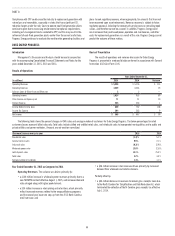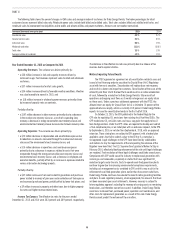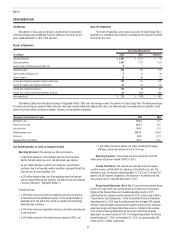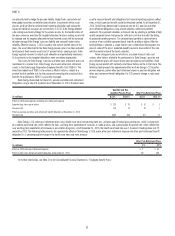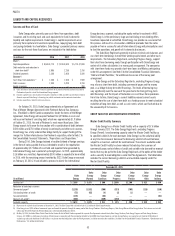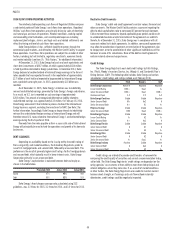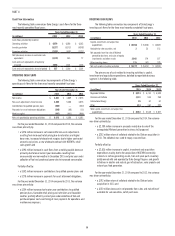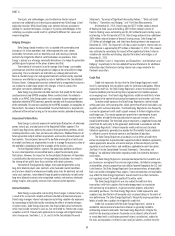Duke Energy 2015 Annual Report Download - page 74
Download and view the complete annual report
Please find page 74 of the 2015 Duke Energy annual report below. You can navigate through the pages in the report by either clicking on the pages listed below, or by using the keyword search tool below to find specific information within the annual report.
54
PART II
Piedmont Bridge Facility
In connection with the Merger Agreement with Piedmont, Duke Energy
entered into a $4.9 billion Bridge Facility with Barclays. The Bridge Facility, if
drawn upon, may be used to (i) fund the cash consideration for the transaction
and (ii) pay certain fees and expenses in connection with the transaction. In
November 2015, Barclays syndicated its commitment under the Bridge Facility
to a broader group of lenders. Duke Energy intends to finance the transaction
with proceeds raised through the issuance of debt, equity and other sources as
noted above and, therefore, does not expect to draw upon the Bridge Facility.
Short-Term Loan Facility
On February 22, 2016, Duke Energy entered into a six-month term loan
facility (Term Loan) with commitments totaling $1 billion to provide additional
flexibility in managing short-term liquidity. The Term Loan can be drawn upon in
a single borrowing of up to $1 billion, which must occur no later than 45 calendar
days following February 22, 2016. As of February 24, 2016, no amounts have
been drawn under the Term Loan. Amounts drawn under this facility, if any, will be
due on August 19, 2016. The terms and conditions of this Term Loan are generally
consistent with those governing the Master Credit Facility discussed above.
Shelf Registration
In September 2013, Duke Energy filed a registration statement (Form S-3)
with the SEC. Under this Form S-3, which is uncapped, the Duke Energy
Registrants, excluding Progress Energy may issue debt and other securities
in the future at amounts, prices and with terms to be determined at the time
of future offerings. The registration statement also allows for the issuance of
common stock by Duke Energy.
CAPITAL EXPENDITURES
Duke Energy continues to focus on reducing risk and positioning its
business for future success and will invest principally in its strongest business
sectors. Based on this goal, the majority of Duke Energy’s total projected capital
expenditures are allocated to the Regulated Utilities segment. Duke Energy’s
projected capital and investment expenditures for the next three fiscal years are
included in the table below.
(in millions) 2016 2017 2018
New generation $ 1,275 $ 925 $ 825
Environmental 350 425 200
Nuclear fuel 525 425 425
Major nuclear 175 200 75
Customer additions 500 575 575
Grid modernization and other transmission and
distribution projects 1,300 1,475 1,575
Maintenance 2,700 2,325 2,200
Total Regulated Utilities 6,825 6,350 5,875
Commercial Portfolio, International Energy and Other 1,775 950 900
Total committed expenditures 8,600 7,300 6,775
Discretionary expenditures 175 1,200 1,025
Total projected capital and investment expenditures $ 8,775 $ 8,500 $ 7,800
DEBT MATURITIES
The following table shows the significant components of Current
maturities of Long-Term Debt on the Consolidated Balance Sheets. The Duke
Energy Registrants currently anticipate satisfying these obligations with cash on
hand and proceeds from additional borrowings.
(in millions) Maturity Date Interest Rate December 31, 2015
Unsecured Debt
Progress Energy (Parent) January 2016 5.625% $ 300
Duke Energy Indiana June 2016 6.05% 325
Duke Energy (Parent) November 2016 2.150% 500
First Mortgage Bonds
Duke Energy Indiana July 2016 0.670% 150
Duke Energy Carolinas December 2016 1.750% 350
Other 449
Current maturities of
long-term debt $ 2,074
DIVIDEND PAYMENTS
In 2015, Duke Energy paid quarterly cash dividends for the 90th
consecutive year and expects to continue its policy of paying regular cash
dividends in the future. There is no assurance as to the amount of future
dividends because they depend on future earnings, capital requirements,
financial condition and are subject to the discretion of the Board of Directors.
Through 2020, the dividend payout ratio is expected to be between 70
and 75 percent, based upon adjusted diluted EPS. Over the past several years,
Duke Energy’s dividend has grown at approximately 2 percent annually, slower
than overall adjusted earnings growth. In 2015, Duke Energy increased the
dividend payout to grow the dividend at approximately 4 percent annually, better
matching expected future earnings growth.
Dividend and Other Funding Restrictions of Duke Energy Subsidiaries
As discussed in Note 4 to the Consolidated Financial Statements,
“Regulatory Matters,” Duke Energy’s wholly owned public utility operating
companies have restrictions on the amount of funds that can be transferred
to Duke Energy through dividends, advances or loans as a result of conditions
imposed by various regulators in conjunction with merger transactions. Duke
Energy Progress and Duke Energy Florida also have restrictions imposed by
their first mortgage bond indentures and Articles of Incorporation which in
certain circumstances limit their ability to make cash dividends or distributions
on common stock. Additionally, certain other Duke Energy subsidiaries have
other restrictions, such as minimum working capital and tangible net worth
requirements pursuant to debt and other agreements that limit the amount
of funds that can be transferred to Duke Energy. At December 31, 2015, the
amount of restricted net assets of wholly owned subsidiaries of Duke Energy
that may not be distributed to Duke Energy in the form of a loan or dividend
is less than 25 percent of Duke Energy’s net assets. Duke Energy does
not have any legal or other restrictions on paying common stock dividends
to shareholders out of its consolidated equity accounts. Although these
restrictions cap the amount of funding the various operating subsidiaries can
provide to Duke Energy, management does not believe these restrictions will
have a significant impact on Duke Energy’s ability to access cash to meet its
payment of dividends on common stock and other future funding obligations.


